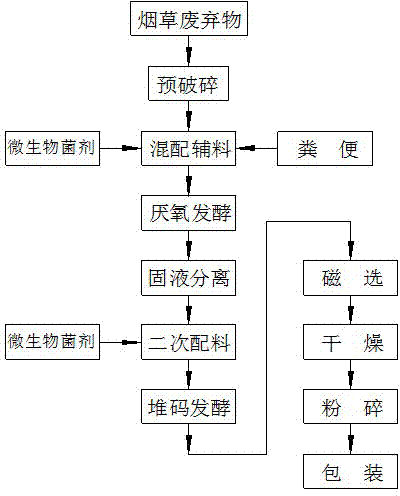Process for producing marsh gas and bioorganic fertilizer by utilizing tobacco waste
A technology of tobacco waste and bio-organic fertilizer, which is applied in the preparation of organic fertilizers, the treatment of bio-organic parts, organic fertilizers, etc., can solve the problems of low economic value, mosaic disease infection, and unsuitable for processing feed, etc., and achieve good economy Benefits and social benefits, the effect of realizing recycling
- Summary
- Abstract
- Description
- Claims
- Application Information
AI Technical Summary
Problems solved by technology
Method used
Image
Examples
Embodiment 1
[0022] The present embodiment utilizes the technology of tobacco waste production biogas and bio-organic fertilizer, comprises the following steps:
[0023] a. Pre-shredding: use a shredder to shred the tobacco waste into 20mm blocks or strips;
[0024] B, mixing auxiliary material: take the tobacco waste after 1000kg crushing, add 500kg excrement and 3kg microbial inoculum, described microbial inoculum comprises 50% Bacillus subtilis and 50% Bacillus licheniformis, stir after mixing;
[0025] c. Anaerobic fermentation: Put the mixed materials into a closed fermentation tank for anaerobic fermentation to obtain biogas, which is used for combustion, lighting or power generation;
[0026] d. Solid-liquid separation: solid-liquid separation of biogas residue and biogas slurry after biogas production;
[0027] e. Secondary ingredients: Weigh 1000kg of biogas residue, add 200kg of biogas slurry and 2kg of microbial inoculum, said microbial inoculum includes 70% of Bacillus subtil...
Embodiment 2
[0035] The present embodiment utilizes the technology of tobacco waste production biogas and bio-organic fertilizer, comprises the following steps:
[0036] a. Pre-shredding: Use a shredder to shred the tobacco waste into 10mm blocks or strips;
[0037] B, mixing auxiliary material: take the tobacco waste after 1000kg crushing, add 1000kg excrement and 1kg microbial inoculum, described microbial inoculum comprises 70% Bacillus subtilis and 30% Bacillus licheniformis, stir after mixing;
[0038] c. Anaerobic fermentation: Put the mixed materials into a closed fermentation tank for anaerobic fermentation to obtain biogas, which is used for combustion, lighting or power generation;
[0039] d. Solid-liquid separation: solid-liquid separation of biogas residue and biogas slurry after biogas production;
[0040] e, secondary batching: take 1000kg biogas residue, add 500kg biogas slurry and 0.5kg microbial inoculum, said microbial inoculum includes 50% Bacillus subtilis and 50% Bac...
Embodiment 3
[0048] The present embodiment utilizes the technology of tobacco waste production biogas and bio-organic fertilizer, comprises the following steps:
[0049] a. Pre-shredding: Use a shredder to shred the tobacco waste into 15mm blocks or strips;
[0050] B, mixing auxiliary material: take the tobacco waste after 1000kg crushing, add 800kg excrement and 2kg microbial inoculum, described microbial inoculum comprises 60% Bacillus subtilis and 40% Bacillus licheniformis, stir after mixing;
[0051] c. Anaerobic fermentation: Put the mixed materials into a closed fermentation tank for anaerobic fermentation to obtain biogas, which is used for combustion, lighting or power generation;
[0052] d. Solid-liquid separation: solid-liquid separation of biogas residue and biogas slurry after biogas production;
[0053] e. Secondary ingredients: Weigh 1000kg of biogas residue, add 300kg of biogas slurry and 1kg of microbial inoculum, the microbial inoculum includes 50% of Bacillus subtilis...
PUM
| Property | Measurement | Unit |
|---|---|---|
| particle size | aaaaa | aaaaa |
| particle size | aaaaa | aaaaa |
| particle size | aaaaa | aaaaa |
Abstract
Description
Claims
Application Information
 Login to View More
Login to View More - R&D
- Intellectual Property
- Life Sciences
- Materials
- Tech Scout
- Unparalleled Data Quality
- Higher Quality Content
- 60% Fewer Hallucinations
Browse by: Latest US Patents, China's latest patents, Technical Efficacy Thesaurus, Application Domain, Technology Topic, Popular Technical Reports.
© 2025 PatSnap. All rights reserved.Legal|Privacy policy|Modern Slavery Act Transparency Statement|Sitemap|About US| Contact US: help@patsnap.com

